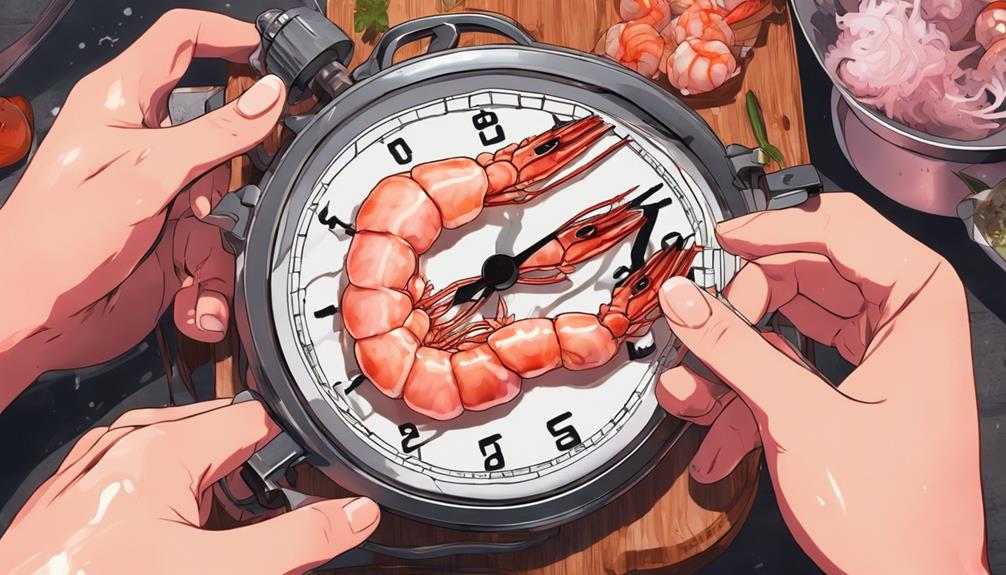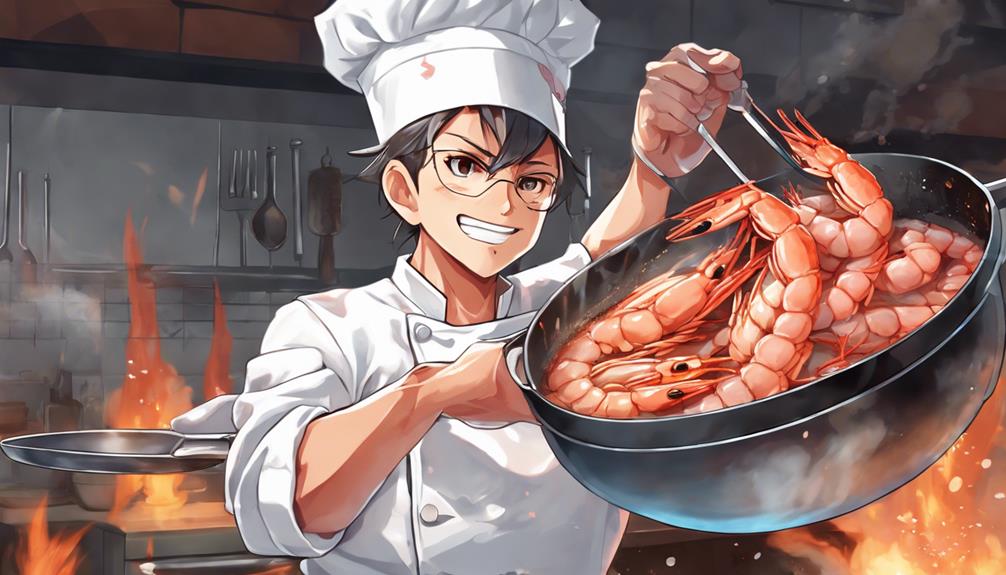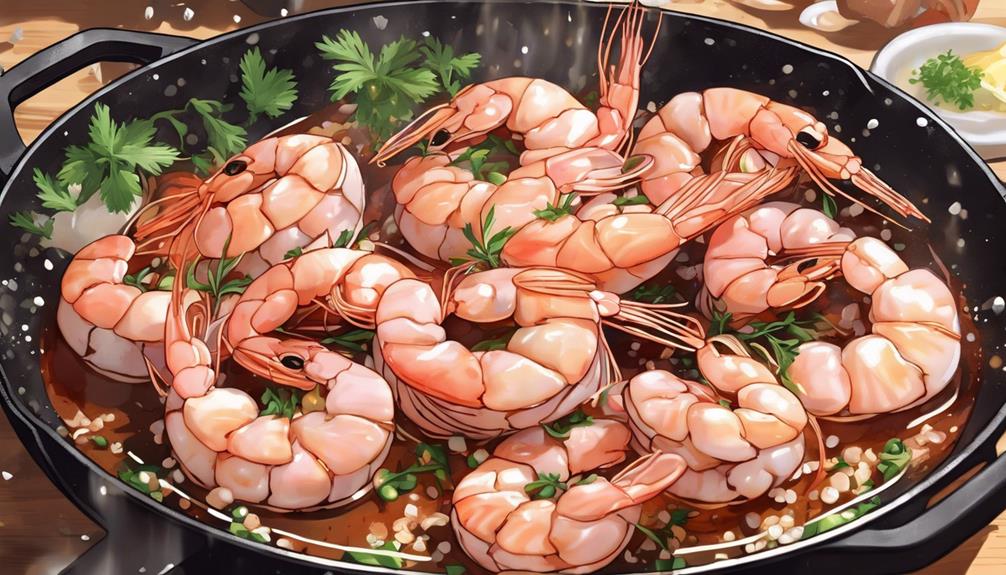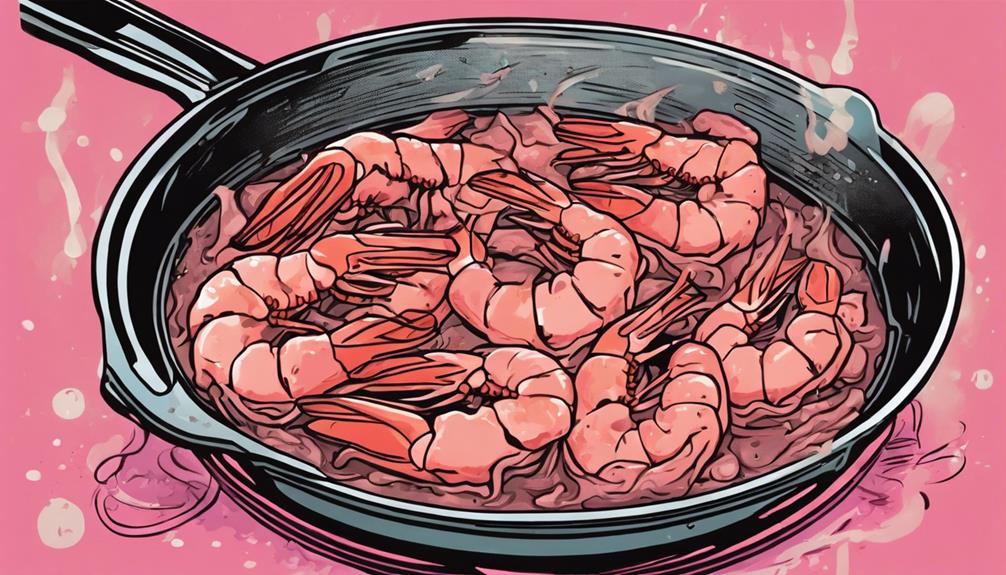So, you've got some raw shrimp and a sizzling pan ready to groove! The shrimp usually need around 2-3 minutes per side to sauté to perfection. Keep an eye out for that lovely opaque and pink color – it's the shrimp's way of saying, 'I'm ready to be devoured!' But hey, this is just the beginning of discovering all the secrets to mastering the art of sautéing these little ocean gems!
Main Points
- Shrimp usually cook in 2-3 minutes per side.
- Visual cues like opacity and pinkness indicate readiness.
- Trust instincts and sensory cues for doneness.
- Fragrant smell and firm texture signal perfect cooking.
- Avoid overcooking for tender, juicy shrimp.
Factors Affecting Sautéing Time

When sautéing raw shrimp, the factors that impact the cooking time are essential to ensure a perfectly cooked dish. The size of the shrimp plays a significant role in determining how long they need to sizzle in the pan. Larger shrimp will naturally take longer to cook through, while smaller shrimp will be done much quicker. It's like wrangling a group of unruly shrimp at a party – the big ones need more time to get into the groove while the little ones are already dancing up a storm.
Another critical factor is the temperature of your pan. If it's too hot, your shrimp could end up overcooked and rubbery. Too low, and you risk them being undercooked and unsafe to eat. It's a delicate balance, like trying to juggle shrimp on a unicycle – one wrong move, and it all comes crashing down.
Recommended Sautéing Time for Shrimp
To achieve perfectly sautéed shrimp that are tender and flavorful, timing is everything when it comes to cooking these delectable crustaceans. Here are some guidelines to help you nail the recommended sautéing time for shrimp:
- Size Matters: Larger shrimp will need a tad more time in the pan, while smaller ones cook up quickly.
- Keep an Eye Out: Shrimp turn opaque and pink when cooked, so watch for this visual cue.
- Don't Overdo It: Overcooking shrimp can turn them rubbery, so aim for just the right doneness.
- Quick and Easy: Shrimp cook fast, usually within 2-3 minutes per side, depending on size.
- Trust Your Instincts: If they smell fragrant and look plump, they're likely done; a quick taste test can confirm.
Checking Shrimp Doneness

To gauge the doneness of your sautéed shrimp, trust your senses and look for visual cues of plumpness and fragrant aromas emanating from the succulent crustaceans. As you watch the shrimp sizzle in the pan, keep an eye out for that telltale pink color that signifies they're cooked to perfection. The shrimp should curl up slightly and have a firm texture but still retain a juicy interior. When you press down gently on the shrimp with a spatula, they should bounce back slightly, indicating they're ready to be devoured.
Additionally, use your nose to pick up the delicious scent of the shrimp as they cook. The aroma should be enticing and mouth-watering, signaling that the shrimp are reaching their peak flavor. Trust your instincts and remember that overcooked shrimp can turn rubbery and lose their delicate taste, so it's better to slightly undercook them than to risk making them tough and unappetizing. Enjoy the sensory experience of cooking shrimp and revel in the delightful moment when you know they're just right.
Overcooking Risks to Avoid
Avoid the culinary tragedy of turning your succulent shrimp into chewy erasers by mastering the art of precise timing and attentive cooking techniques. Overcooking shrimp can quickly transform a delightful meal into a rubbery disaster. To prevent this seafood catastrophe, keep the following risks in mind:
- Tough Texture: Cooking shrimp for too long will result in a tough and rubbery texture that no amount of sauce can salvage.
- Loss of Flavor: Overcooking can cause shrimp to lose their delicate flavor, leaving you with a bland dish that lacks the essence of the sea.
- Shrinkage: Shrimp will shrink considerably when overcooked, making them less visually appealing and reducing the overall portion size.
- Dryness: Extended cooking times can dry out shrimp, robbing them of their natural juiciness and leaving them parched and unappetizing.
- Burnt Taste: Continuing to cook shrimp past their best point can lead to a burnt taste, overpowering any other seasonings or flavors present in the dish.
Tips for Perfectly Sautéed Shrimp

For shrimp that sizzle just right in the pan, let's explore the secrets of achieving perfectly sautéed goodness. To guarantee your shrimp dish is a hit, follow these tips:
| Tips for Perfectly Sautéed Shrimp | Benefits |
|---|---|
| Use a hot pan | Promotes quick cooking and a nice sear |
| Pat shrimp dry before cooking | Prevents excess moisture, assisting in browning |
| Season shrimp before cooking | Enhances flavor and improves the overall taste |
| Don't overcrowd the pan | Allows shrimp to cook evenly and not steam |
| Cook until just opaque | Avoiding overcooking, which results in rubbery shrimp, aim for tenderness |
Picture the sound of shrimp hitting the hot pan, the sizzle promising delicious results. As you master these tips, your shrimp will be flavorful, tender, and perfectly sautéed every time. So, grab your pan, heat it up, and get ready to sauté your way to shrimp perfection!
Conclusion
Congratulations, you've mastered the art of sautéing shrimp!
With just a few minutes on the heat, you can achieve perfectly cooked, tender shrimp every time.
Remember, timing is key to avoiding rubbery, overcooked seafood.
So next time you're in the kitchen, don't shrimp out on the sautéing process.
Embrace the sizzle and enjoy the mouthwatering results of your culinary skills.
Happy cooking!
